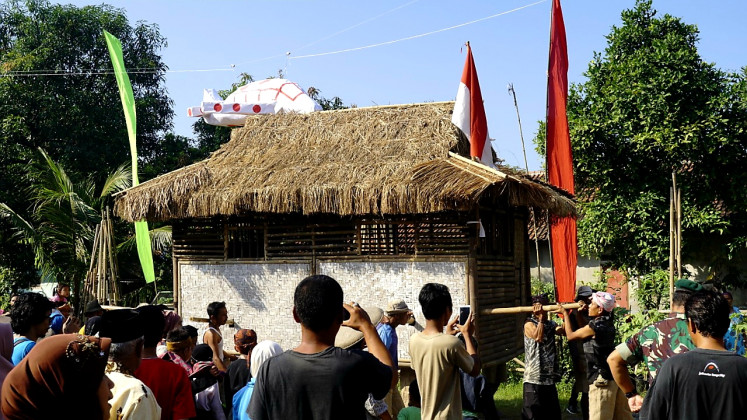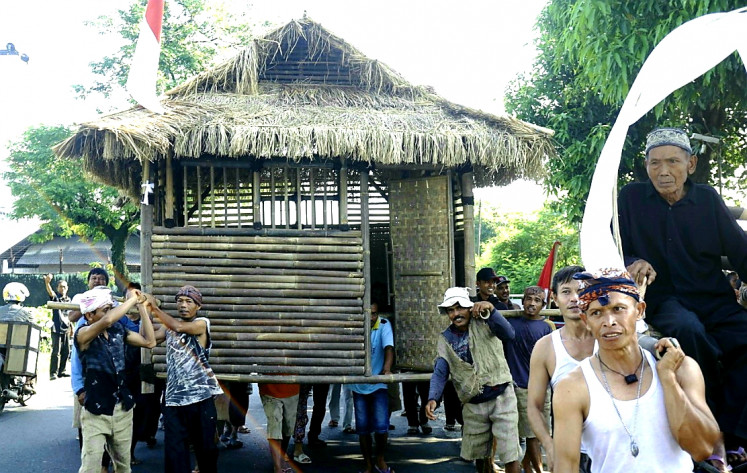Popular Reads
Top Results
Can't find what you're looking for?
View all search resultsPopular Reads
Top Results
Can't find what you're looking for?
View all search resultsWomen make difference through art
Change text size
Gift Premium Articles
to Anyone
W
omen are still underrepresented in Indonesia’s art scene, but it does not mean that the country is lacking great female artists. Meet Erni Aladjai and Bunga Siagian who create and utilize art to empower communities.
Erni has a well-established career as an author. The 33-year-old penned four novels, including Kei, which took first place in the 2011 Jakarta Arts Council novel competition.
What is not known to the public is that Erni lends her craft to better her hometown, Banggai Laut regency in Central Sulawesi. She established the Bois Pustaka children’s library and recently revived the forgotten oral tradition of paupe.
Originating in the Banggai kingdom in the 15th century, paupe consists of verses that center on human relationships and the harmony between humans, nature and God.
Paupe was part of Banggai Laut residents' daily life until televisions arrived in the 1990s. The residents preferred to watch soap operas at home rather than sing paupe with their neighbors at the village hall -- resulting in growing individualism.
Erni worked hard to revive the centuries-old tradition with the support of Hibah Cipta Perdamaian (Peacemaking Art Grant), which forms part of the Kelola Foundation, and the Danish Embassy in Indonesia in 2016.
Recently, she shared her journey to preserve paupe in a discussion titled Aktivisme Seni 101 (Art Activism 101) at the Aksara bookstore in Jakarta.
Banggai Laut’s residents used to sing paupe while going about their daily activities -- from rocking the baby to sleep and cooking to going to sea.
While Erni was attempting to resurrect the oral tradition in the region, she saw that it could be used for a greater good: healing a rift that had developed between Banggai Laut’s residents.
Between 2007 and 2008, the regency was rocked by a series of riots, stemming from the government’s decision to move Banggai Laut’s capital city from Banggai to Salakan. This created protracted tension between residents of different villages.
Erni used the art grant to hold a four-day event, bringing together junior and senior high school students from conflicting villages to enhance their writing skills and sing paupe.
She later invited people from across Banggai Laut to watch a paupe art performance, which served as a platform for residents to interact and find common ground.
Slowly but surely, paupe returned to Banggai Laut.
“Today, people hold paupe performances when celebrating Independence Day, Mother’s Day, Kartini Day, and other events,” Erni said.
Art of resistance
Meanwhile, artist Bunga Siagian used art to address injustices visited upon people in Jatiwangi, Majalengka, West Java.
She is part of the Jatiwangi art Factory (JaF) community, which received the Kelola Foundation’s art grant in 2015.
In the clay-rich region of Jatiwangi, JaF has been teaching brick and roof tile makers to make ceramic and other artworks. They also use art performances to highlight their opposition to excessive exploitation of natural resources and land conflicts in the region.
Bunga heads JaF’s Badan Kajian Pertanahan (Land Study Body) that helps the residents of Wates village to host the annual art performance Gotong Rumah (Lifting House).
Moving house: The residents of Wates village in Majalengka, West Java, carry a house during an art performance. (Bunga Siagian /-)The performance is a symbolic protest against the Indonesian Air Force, which has laid claim to the residents’ land in Wates village since 1950.
Residents filed a lawsuit against the air force, but lost the case in 1972. They resisted the verdict, prompting military personnel to intimidate them in the 1980s.
“They were beaten up, and the houses they had constructed were demolished,” Bunga said.
During the performance, the villagers lift a house during a march and then walk around Tumpeng Tanah, a cone-shaped ceramic that has a diameter of 1.5 meters. A respected figure from the village then symbolically hands over the cone to young residents in the hope that they will continue the fight.
The Gotong Rumah art performance was inspired by the eviction of Wates’ villagers when it was occupied by the Japanese in 1943. Japan planned to build an airfield in the village, so the people carried their houses to another village. After Japan was defeated, the residents returned to their land but it turned out that the air force had claimed it.
It’s a man’s world
Kelola Foundation director Gita Hastarik calls Bunga and Erni agents of change.
“What is interesting about Erni and Bunga is that they do not label themselves as artists. They have positioned themselves as part of society,” she said.
Founded in 1999, the foundation has given art grants to Indonesian artists every year. In 2006, it started to award Hibah Cipta Perempuan art grants to female artists only.
So far, Hibah Cipta Perempuan has been awarded to over 20 female artists across the archipelago, from Sawung Dance Studio founder Sekar Alit from Surabaya, East Java, to singer Septina Rosalina Layan from Papua.
Gita said having more female artists was essential, but what was more important was to empower them so that they could create better works.
“In the art world, if women stop creating art, our generation will always learn about music, dance and theater from a man’s perspective. When we talk about theater, for example, we know Shakespeare, Arifin C. Noer, Putu Wijaya, and others. They all are men,” she added.
“They learn theater from the mindset of men. Women have to keep producing art so that the next generation will have another perspective that is different from men’s.”













